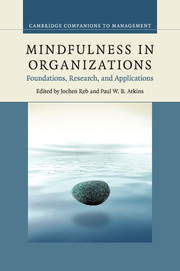Book contents
- Frontmatter
- Contents
- List of figures
- List of tables
- List of contributors
- Foreword
- Preface
- Part I Foundations
- Part II Research
- 6 Mindfulness, identity and work: mindfulness training creates a more flexible sense of self
- 7 Improving decision making through mindfulness
- 8 Mindfulness and creativity in the workplace
- 9 How being mindful impacts individuals' work-family balance, conflict, and enrichment: a review of existing evidence, mechanisms and future directions
- 10 Building and maintaining better leadership relationships through mindfulness
- 11 Leading with mindfulness: exploring the relation of mindfulness with leadership behaviors, styles, and development
- 12 Mindfulness in interpersonal negotiations: delineating the concept of mindfulness and proposing a mindful, relational self-regulation (MRSR) model
- 13 Drawing the line: sketching out the role of visual templates in individual mindfulness and mindful organizing
- Part III Applications
- Index
- References
10 - Building and maintaining better leadership relationships through mindfulness
from Part II - Research
Published online by Cambridge University Press: 05 July 2015
- Frontmatter
- Contents
- List of figures
- List of tables
- List of contributors
- Foreword
- Preface
- Part I Foundations
- Part II Research
- 6 Mindfulness, identity and work: mindfulness training creates a more flexible sense of self
- 7 Improving decision making through mindfulness
- 8 Mindfulness and creativity in the workplace
- 9 How being mindful impacts individuals' work-family balance, conflict, and enrichment: a review of existing evidence, mechanisms and future directions
- 10 Building and maintaining better leadership relationships through mindfulness
- 11 Leading with mindfulness: exploring the relation of mindfulness with leadership behaviors, styles, and development
- 12 Mindfulness in interpersonal negotiations: delineating the concept of mindfulness and proposing a mindful, relational self-regulation (MRSR) model
- 13 Drawing the line: sketching out the role of visual templates in individual mindfulness and mindful organizing
- Part III Applications
- Index
- References
Summary
Introduction
As his wife drove up to the train station, Dimitrios picked up his attaché and opened the car door. They were chatting about something seemingly unimportant as the 7:10 train arrived into the station. They kissed good bye and yet he sat there, with the car door open but not moving. The train blew its whistle and his wife said, “You's going to miss the train.” His shoulders slumped, he still sat there. The train began to leave the station and she said, “What's wrong?” “There is another train at 7:20,” he explained. Then added, “I just don's want to go to work.” She asked, “Why?” He then said an odd thing, “I don's like it there.” While this exchange could have happened in hundreds, if not thousands of homes that day about people not wanting to go to work for a wide variety of reasons, Dimitrios' wife's response clarified that most of the reasons others might have had were not his: “But you's the boss. You are the CEO. If you don's like what it's like in the company, change it!” So he smiled and said, “Yeah, sure.” And then kissed her again and begrudgingly walked through the station to the train platform.
It did not make sense to him. The company was doing well. It had grown under his leadership from about sixteen people to over one hundred. It was a well-respected consulting company sought after by many organizations around the world. Dimitrios was not aware that the changes had happened inside him, not the company. The “thing” he did not like was how he was feeling, but he did not know why and had misdiagnosed it.
This happens to almost everyone at some point in their life. For some, it happens like a bad habit which you cannot shake. You change slowly and do not notice until the signs are too obvious to ignore.
- Type
- Chapter
- Information
- Mindfulness in OrganizationsFoundations, Research, and Applications, pp. 239 - 255Publisher: Cambridge University PressPrint publication year: 2015
References
- 3
- Cited by



